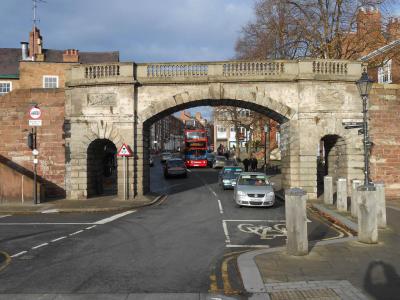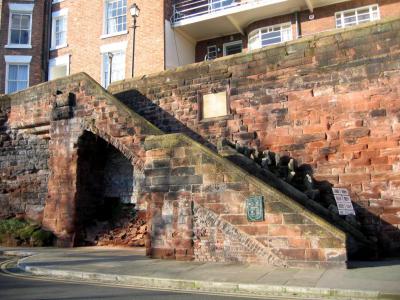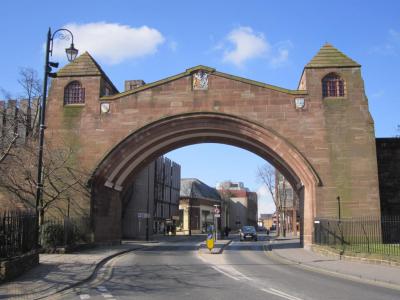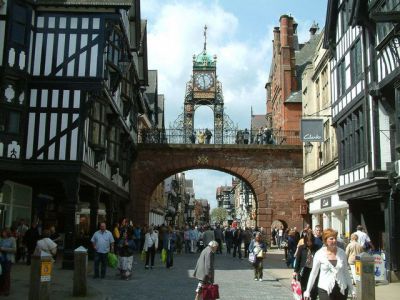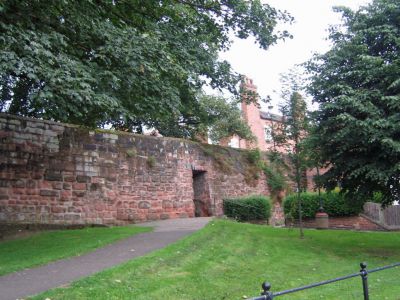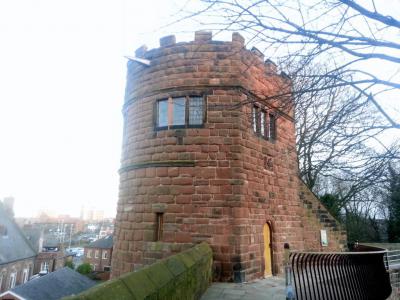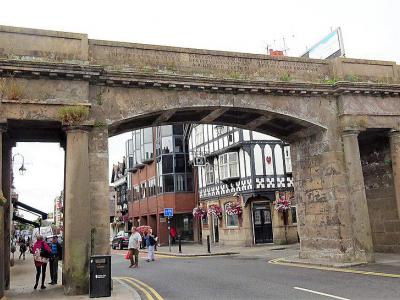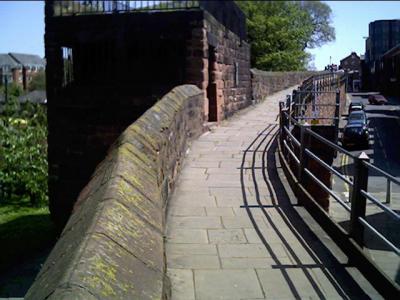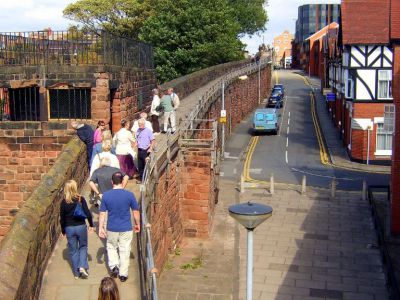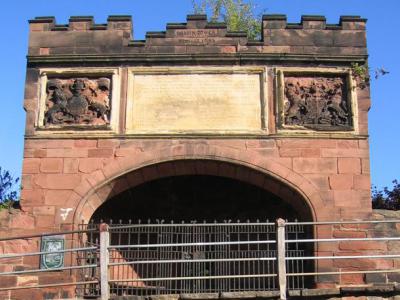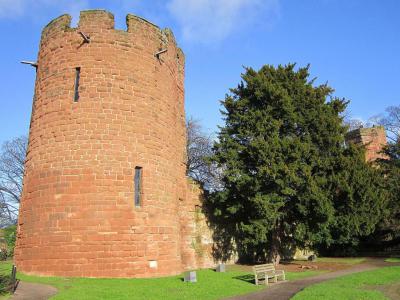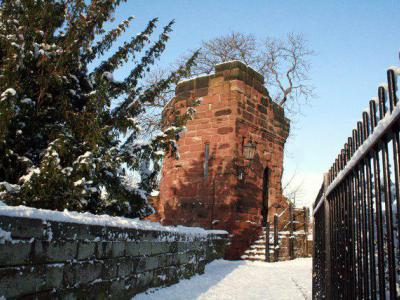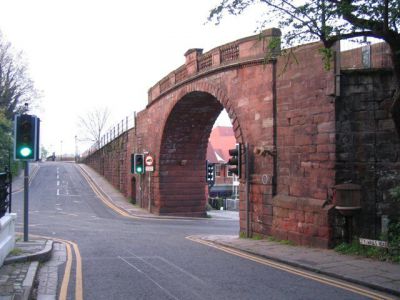Chester's City Walls (Self Guided), Chester
Chester City Walls are the oldest, longest and most complete (missing only just about 100 meters) historic defensive structure in Britain. Walking the full circuit of this ancient fortification provides wondrous views, wherever you choose to go, down into the city, and offers a fantastic insight into Chester's rich history.
First built by the Romans almost 2,000 years ago, the Walls were extended and developed during the Saxon period (10th century), and then further modified in the 12th century by the Normans. Eventually, through various additions and alterations, they had formed a complete circuit around Chester, making it one of the most protected and strategically important city in the country, back in the middle ages.
One of the reasons the Walls have survived until present is that since the 18th century they had ceased being used for defense and been adapted to become a fashionable walk and public amenity. The main access onto the Walls is via four major gateways: Northgate, Eastgate, Watergate and Bridgegate. There are also many steps along the Walls, such as Recorder's Steps, some having accessible ramps; plus a number of towers, including Water Tower, Phoenix Tower, and Bonewaldesthorne's Tower.
If you wish to travel back in time down the ancient Walls of Chester and learn about its eventful past, take this self-guided walking tour.
First built by the Romans almost 2,000 years ago, the Walls were extended and developed during the Saxon period (10th century), and then further modified in the 12th century by the Normans. Eventually, through various additions and alterations, they had formed a complete circuit around Chester, making it one of the most protected and strategically important city in the country, back in the middle ages.
One of the reasons the Walls have survived until present is that since the 18th century they had ceased being used for defense and been adapted to become a fashionable walk and public amenity. The main access onto the Walls is via four major gateways: Northgate, Eastgate, Watergate and Bridgegate. There are also many steps along the Walls, such as Recorder's Steps, some having accessible ramps; plus a number of towers, including Water Tower, Phoenix Tower, and Bonewaldesthorne's Tower.
If you wish to travel back in time down the ancient Walls of Chester and learn about its eventful past, take this self-guided walking tour.
How it works: Download the app "GPSmyCity: Walks in 1K+ Cities" from Apple App Store or Google Play Store to your mobile phone or tablet. The app turns your mobile device into a personal tour guide and its built-in GPS navigation functions guide you from one tour stop to next. The app works offline, so no data plan is needed when traveling abroad.
Chester's City Walls Map
Guide Name: Chester's City Walls
Guide Location: England » Chester (See other walking tours in Chester)
Guide Type: Self-guided Walking Tour (Sightseeing)
# of Attractions: 13
Tour Duration: 2 Hour(s)
Travel Distance: 2.3 Km or 1.4 Miles
Author: rose
Sight(s) Featured in This Guide:
Guide Location: England » Chester (See other walking tours in Chester)
Guide Type: Self-guided Walking Tour (Sightseeing)
# of Attractions: 13
Tour Duration: 2 Hour(s)
Travel Distance: 2.3 Km or 1.4 Miles
Author: rose
Sight(s) Featured in This Guide:
- Bridgegate
- Recorder's Steps
- Newgate
- Eastgate and Eastgate Clock
- Kaleyard Gate
- Phoenix Tower
- Northgate
- Morgan's Mount
- St. Martin's Gate
- Pemberton's Parlour
- Water Tower
- Bonewaldesthorne's Tower
- Watergate
1) Bridgegate
Bridgegate in Chester is a historic component of the city's ancient walls and is recognized as a Grade I listed building in the National Heritage List for England. Originally constructed by the 1120s, the gate formed part of a 12th-century extension of the Roman city walls along the north bank of the River Dee. Its strategic importance lay in guarding Chester's southern entrance, with the gateway serving as the passage for travelers from North Wales after crossing the Old Dee Bridge.
Throughout its history, Bridgegate has undergone significant transformations. The original medieval structure, possibly rebuilt during the 14th century to coincide with the reconstruction of the Old Dee Bridge, featured a Gothic arch flanked by towers. By 1600–01, a square tower known as John Tyrer's Water Tower was added to house machinery for pumping river water into the town. However, this tower was destroyed during the Siege of Chester (1644–65).
The present Bridgegate, completed in 1781, was designed by architect Joseph Turner for the Chester City Corporation. Constructed in yellow sandstone ashlar and showcasing a neoclassical style, the gate consists of a segmental arch over the carriageway flanked by round pedestrian archways in each abutment. Its balustraded parapets along the top add a decorative touch while accommodating foot traffic.
Notably, Bridgegate's history intertwines with the Talbot family, the Earls of Shrewsbury, who controlled the bridge tolls from 1521 to 1624. Their nearby townhouse, now the Bear and Billet, remains a connection to this period. Bridgegate stands today as a testament to Chester’s rich medieval and architectural heritage.
Throughout its history, Bridgegate has undergone significant transformations. The original medieval structure, possibly rebuilt during the 14th century to coincide with the reconstruction of the Old Dee Bridge, featured a Gothic arch flanked by towers. By 1600–01, a square tower known as John Tyrer's Water Tower was added to house machinery for pumping river water into the town. However, this tower was destroyed during the Siege of Chester (1644–65).
The present Bridgegate, completed in 1781, was designed by architect Joseph Turner for the Chester City Corporation. Constructed in yellow sandstone ashlar and showcasing a neoclassical style, the gate consists of a segmental arch over the carriageway flanked by round pedestrian archways in each abutment. Its balustraded parapets along the top add a decorative touch while accommodating foot traffic.
Notably, Bridgegate's history intertwines with the Talbot family, the Earls of Shrewsbury, who controlled the bridge tolls from 1521 to 1624. Their nearby townhouse, now the Bear and Billet, remains a connection to this period. Bridgegate stands today as a testament to Chester’s rich medieval and architectural heritage.
2) Recorder's Steps
The Recorder's Steps in Chester consists of two flights of stone steps leading from the historic City Walls down to the riverside promenade known as the Groves. This architectural feature, constructed between 1820 and 1822 for Chester Corporation, is designated as a Grade I listed building under the National Heritage List for England.
The two flights include 12 steps in the upper section and 15 steps in the lower section, separated by a strip of decorative Gothic stonework. Although the steps were built in the 19th century, a nearby stone plaque, likely added in 1881, mistakenly attributes their construction to the year 1700 for the "convenience of Roger Comberbach, Recorder." This inscription perpetuates an inaccuracy, as Comberbach passed away in 1719.
Historical records reveal that in 1720, the city assembly ordered the construction of a flight of stairs connecting the Bridge and Dee Lane, which may have influenced the steps' name. Tragically, not long after, on 21 May 1721, Kenneth Edwards, a local tanner, fell to his death down the "new stairs."
Interestingly, Roger Comberbach’s son, also named Roger, went on to build Dee House in 1730 near the Roman amphitheater, further connecting the family name to Chester's storied landscape.
The Recorder's Steps remain a fascinating piece of Chester's history, offering visitors a tangible link between the city's medieval walls and the picturesque River Dee below.
The two flights include 12 steps in the upper section and 15 steps in the lower section, separated by a strip of decorative Gothic stonework. Although the steps were built in the 19th century, a nearby stone plaque, likely added in 1881, mistakenly attributes their construction to the year 1700 for the "convenience of Roger Comberbach, Recorder." This inscription perpetuates an inaccuracy, as Comberbach passed away in 1719.
Historical records reveal that in 1720, the city assembly ordered the construction of a flight of stairs connecting the Bridge and Dee Lane, which may have influenced the steps' name. Tragically, not long after, on 21 May 1721, Kenneth Edwards, a local tanner, fell to his death down the "new stairs."
Interestingly, Roger Comberbach’s son, also named Roger, went on to build Dee House in 1730 near the Roman amphitheater, further connecting the family name to Chester's storied landscape.
The Recorder's Steps remain a fascinating piece of Chester's history, offering visitors a tangible link between the city's medieval walls and the picturesque River Dee below.
3) Newgate
Newgate in Chester is a striking arch bridge that carries the walkway of the city walls over Pepper Street. Built in 1937–38, it was designed to ease traffic congestion in the city, particularly at the bustling Chester Cross. Its construction necessitated a new breach in Chester's historic city walls, a decision that sparked considerable debate at the time. The bridge, now a Grade II listed building, blends modern functionality with a playful nod to Chester's medieval heritage.
The structure was designed by Sir Walter Tapper and completed by his son, Michael Tapper, after Sir Walter’s death. The bridge combines reinforced concrete with a facing of red Runcorn sandstone, giving it an authentic appearance that complements the surrounding city walls. Architecturally, it exudes a cheerful Gothic Revival style, complete with towers on either side featuring mock loops (unglazed slit windows) and hipped roofs. Flights of steps lead to the towers and the walkway atop the bridge, which is adorned with carved shields and Tudor roses.
Historian Simon Ward remarked that its design fits the "generally medieval feel" of Chester’s city walls. This aesthetic continuity, coupled with its practical purpose, has made Newgate a key part of the city’s heritage. Adding to its charm is its connection to the earlier Peppergate or Wolfgate, nearby remnants of Chester’s past, which was once colloquially called "Newegatt" after its 1553 rebuilding.
Interestingly, the construction of Newgate replaced the original gate due to its inadequacy in accommodating the motor age. The project, completed in just 20 months, culminated in an opening ceremony on October 3, 1938, presided over by the Mayor. Today, Newgate stands as both a functional passage and a visual homage to Chester’s rich history, earning its place on the National Heritage List for England.
The structure was designed by Sir Walter Tapper and completed by his son, Michael Tapper, after Sir Walter’s death. The bridge combines reinforced concrete with a facing of red Runcorn sandstone, giving it an authentic appearance that complements the surrounding city walls. Architecturally, it exudes a cheerful Gothic Revival style, complete with towers on either side featuring mock loops (unglazed slit windows) and hipped roofs. Flights of steps lead to the towers and the walkway atop the bridge, which is adorned with carved shields and Tudor roses.
Historian Simon Ward remarked that its design fits the "generally medieval feel" of Chester’s city walls. This aesthetic continuity, coupled with its practical purpose, has made Newgate a key part of the city’s heritage. Adding to its charm is its connection to the earlier Peppergate or Wolfgate, nearby remnants of Chester’s past, which was once colloquially called "Newegatt" after its 1553 rebuilding.
Interestingly, the construction of Newgate replaced the original gate due to its inadequacy in accommodating the motor age. The project, completed in just 20 months, culminated in an opening ceremony on October 3, 1938, presided over by the Mayor. Today, Newgate stands as both a functional passage and a visual homage to Chester’s rich history, earning its place on the National Heritage List for England.
4) Eastgate and Eastgate Clock (must see)
Eastgate and Eastgate Clock stand on the site of the original entrance gate to the Deva Victrix fortress which was a legionary fortress and town in the Roman province of Britannia. The fortress was built around the AD 70 as the Roman army advanced north against the Brigantes, and rebuilt completely over the next few decades.
The fortress was rebuilt in the early 3rd century. The Roman army probably remained at the fortress until the late 4th or early 5th century, then it fell into disuse. A civilian settlement, or canabae, grew around the fortress and it remained after the Romans departed, eventually becoming the present-day city of Chester.
The original gate is said to date to about AD 74. It was replaced in the 2nd century, and then again in the 14th century. The current Eastgate dates to 1768.
Eastgate Clock was added in 1899 in celebration of Queen Victoria's diamond jubilee. It was designed by architect John Douglas. It has a face on all four sides with the year 1897 and initials VR appearing above and below each clock face. A copper ogee cupola is mounted over the clock with a large weather vane.
It is said that Eastgate Clock is the second most photographed clock in England after Big Ben in London. Eastgate and Eastgate Clock are among the most well-known landmarks in the city. They were designated as a Grade I listed building in 1955.
The fortress was rebuilt in the early 3rd century. The Roman army probably remained at the fortress until the late 4th or early 5th century, then it fell into disuse. A civilian settlement, or canabae, grew around the fortress and it remained after the Romans departed, eventually becoming the present-day city of Chester.
The original gate is said to date to about AD 74. It was replaced in the 2nd century, and then again in the 14th century. The current Eastgate dates to 1768.
Eastgate Clock was added in 1899 in celebration of Queen Victoria's diamond jubilee. It was designed by architect John Douglas. It has a face on all four sides with the year 1897 and initials VR appearing above and below each clock face. A copper ogee cupola is mounted over the clock with a large weather vane.
It is said that Eastgate Clock is the second most photographed clock in England after Big Ben in London. Eastgate and Eastgate Clock are among the most well-known landmarks in the city. They were designated as a Grade I listed building in 1955.
5) Kaleyard Gate
The Kaleyard Gate is a modest yet historically significant feature of Chester’s iconic City Walls. Unlike the grander gates of the city, the Kaleyard Gate is a simple postern – a narrow breach in the sandstone wall, fitted with a sturdy oak door. Its unassuming appearance belies its fascinating backstory, which dates back to the 13th century.
In 1275, the monks of Saint Werburgh’s Abbey sought a more direct route to their vegetable garden, or “kaleyard,” located outside the City Walls. The Abbot petitioned Edward I for permission to create a shortcut through the wall, bypassing the longer trek via Eastgate. The King granted this request on the condition that the gate would be locked at nightfall, ensuring the city’s defenses remained intact in an era of frequent armed threats.
After the dissolution of monasteries under Henry VIII, the responsibility for securing the Kaleyard Gate was transferred to the Dean and Chapter of Chester Cathedral. The gate remained part of Chester's unique nightly ritual, tied to the ancient Norman law of couvre feu-a curfew requiring all fires to be extinguished for the safety of the largely timber-built city. This tradition continues to this day, with the Cathedral’s belfry tolling the curfew bell at 8:45 pm, and the gate being locked at 9:00 pm, reopening at sunrise.
Although the practice was briefly suspended out of safety concerns for Cathedral staff, it was revived in June 2012. Today, the Kaleyard Gate is locked by a Cathedral Constable, an office established in 2011 to safeguard the Cathedral and its estate. As the only remaining city gate in Chester where this ancient custom is still observed, the Kaleyard Gate stands as a unique reminder of the city’s medieval history and enduring traditions.
In 1275, the monks of Saint Werburgh’s Abbey sought a more direct route to their vegetable garden, or “kaleyard,” located outside the City Walls. The Abbot petitioned Edward I for permission to create a shortcut through the wall, bypassing the longer trek via Eastgate. The King granted this request on the condition that the gate would be locked at nightfall, ensuring the city’s defenses remained intact in an era of frequent armed threats.
After the dissolution of monasteries under Henry VIII, the responsibility for securing the Kaleyard Gate was transferred to the Dean and Chapter of Chester Cathedral. The gate remained part of Chester's unique nightly ritual, tied to the ancient Norman law of couvre feu-a curfew requiring all fires to be extinguished for the safety of the largely timber-built city. This tradition continues to this day, with the Cathedral’s belfry tolling the curfew bell at 8:45 pm, and the gate being locked at 9:00 pm, reopening at sunrise.
Although the practice was briefly suspended out of safety concerns for Cathedral staff, it was revived in June 2012. Today, the Kaleyard Gate is locked by a Cathedral Constable, an office established in 2011 to safeguard the Cathedral and its estate. As the only remaining city gate in Chester where this ancient custom is still observed, the Kaleyard Gate stands as a unique reminder of the city’s medieval history and enduring traditions.
6) Phoenix Tower
Phoenix Tower, also known historically as Newton Tower and King Charles' Tower, stands at the northeast corner of Chester's city walls. This Grade I listed building, with origins dating back to the 13th century, is an iconic landmark steeped in history and legend.
Initially constructed in red-coursed sandstone, the tower comprises four stages, with its lower two levels situated below the city wall’s walkway. Its design includes an octagonal lower chamber measuring approximately 30 feet (9 meters) in diameter, adorned with five slit windows. A string course separates the upper two stages, which feature leaded casement windows and a battlemented parapet, topped with a distinctive lead hip roof and ornate weathervane.
In the late 16th century, the Phoenix Tower was leased to the Painters and Stationers and the Barbers and Chandlers guilds. A 1613 plaque with a phoenix emblem marks their restoration of the tower. During the English Civil War, it housed artillery during the 1645 Siege of Chester. Legend claims King Charles I watched his troops' defeat at Rowton Heath from its summit, though this is debated.
After the guilds relinquished possession of the tower in the late 18th century, the city took over its upkeep. By the 19th century, Phoenix Tower had become a tourist attraction due to its royal connections. It also served various uses, including a print shop and a private museum.
Today, the tower remains a testament to Chester's rich history, blending medieval architecture with Civil War lore and the enduring legacy of its guild associations. Its unique features, including the 1613 Phoenix plaque and the commanding views from its battlemented parapet, continue to captivate visitors exploring Chester's city walls.
Initially constructed in red-coursed sandstone, the tower comprises four stages, with its lower two levels situated below the city wall’s walkway. Its design includes an octagonal lower chamber measuring approximately 30 feet (9 meters) in diameter, adorned with five slit windows. A string course separates the upper two stages, which feature leaded casement windows and a battlemented parapet, topped with a distinctive lead hip roof and ornate weathervane.
In the late 16th century, the Phoenix Tower was leased to the Painters and Stationers and the Barbers and Chandlers guilds. A 1613 plaque with a phoenix emblem marks their restoration of the tower. During the English Civil War, it housed artillery during the 1645 Siege of Chester. Legend claims King Charles I watched his troops' defeat at Rowton Heath from its summit, though this is debated.
After the guilds relinquished possession of the tower in the late 18th century, the city took over its upkeep. By the 19th century, Phoenix Tower had become a tourist attraction due to its royal connections. It also served various uses, including a print shop and a private museum.
Today, the tower remains a testament to Chester's rich history, blending medieval architecture with Civil War lore and the enduring legacy of its guild associations. Its unique features, including the 1613 Phoenix plaque and the commanding views from its battlemented parapet, continue to captivate visitors exploring Chester's city walls.
7) Northgate
The Northgate in Chester is an iconic part of the city’s historic landscape, serving as both a functional and symbolic link between past and present. This Grade I listed structure carries the city walls footpath over Northgate Street and marks the site of Chester’s original northern Roman entrance.
Historically, the Northgate played a minor role during the medieval period, serving primarily as a local access point. At that time, it was a simple rectangular tower with a narrow gateway, later becoming the site of the city jail. Its current form dates to 1810, when the medieval gatehouse was replaced by the design of Thomas Harrison, commissioned by Chester City Council.
Built from pale red sandstone ashlar, the Northgate embodies neoclassical elegance. Its centerpiece is a segmental arch with a coffered soffit, flanked by rectangular portals for pedestrian access. Unfluted Doric half-columns frame the portals, adding symmetry and gravitas. The structure is topped by a dentilled cornice and a paneled parapet, enhancing its stately appearance. True to Harrison’s philosophy of minimalism, the Northgate was constructed using “as few and as huge stones as possible.”
Today, the Northgate serves as a prominent architectural feature of Chester’s city walls, blending its Roman, medieval, and Georgian legacies into one cohesive landmark.
Historically, the Northgate played a minor role during the medieval period, serving primarily as a local access point. At that time, it was a simple rectangular tower with a narrow gateway, later becoming the site of the city jail. Its current form dates to 1810, when the medieval gatehouse was replaced by the design of Thomas Harrison, commissioned by Chester City Council.
Built from pale red sandstone ashlar, the Northgate embodies neoclassical elegance. Its centerpiece is a segmental arch with a coffered soffit, flanked by rectangular portals for pedestrian access. Unfluted Doric half-columns frame the portals, adding symmetry and gravitas. The structure is topped by a dentilled cornice and a paneled parapet, enhancing its stately appearance. True to Harrison’s philosophy of minimalism, the Northgate was constructed using “as few and as huge stones as possible.”
Today, the Northgate serves as a prominent architectural feature of Chester’s city walls, blending its Roman, medieval, and Georgian legacies into one cohesive landmark.
8) Morgan's Mount
Morgan's Mount is a historical structure extending from the north side of Chester's city walls in Cheshire. This Grade I listed building, recorded in the National Heritage List for England, was originally constructed in 1645 during the English Civil War. It served as both an observation platform and a gun emplacement during the siege of Chester.
Initially named the Raised Square Platform, it is believed to have been renamed after Captain William Morgan, a Royalist commander, or possibly his son Edward Morgan. The tower played a significant role during the Battle of Rowton Heath in September 1645, when a cannon positioned on the Mount was destroyed by Parliamentary forces.
The structure is built from red sandstone coursed rubble in a rectangular design. At the level of the city wall walkway, it includes a chamber with barred openings facing west and north. Two short flights of stone steps, one of which incorporates a reused Victorian gravestone, lead to the roof. The roof is enclosed by a stone parapet topped with an iron railing and features an L-shaped stone bench at its northeast corner, offering panoramic views of the Welsh hills.
At the base of the Mount, a life-sized sculpture commemorates the Civil War cannon that was destroyed on this site, preserving the memory of its historical significance. Morgan's Mount remains a prominent feature of Chester's city walls, blending rich history with striking architectural details.
Initially named the Raised Square Platform, it is believed to have been renamed after Captain William Morgan, a Royalist commander, or possibly his son Edward Morgan. The tower played a significant role during the Battle of Rowton Heath in September 1645, when a cannon positioned on the Mount was destroyed by Parliamentary forces.
The structure is built from red sandstone coursed rubble in a rectangular design. At the level of the city wall walkway, it includes a chamber with barred openings facing west and north. Two short flights of stone steps, one of which incorporates a reused Victorian gravestone, lead to the roof. The roof is enclosed by a stone parapet topped with an iron railing and features an L-shaped stone bench at its northeast corner, offering panoramic views of the Welsh hills.
At the base of the Mount, a life-sized sculpture commemorates the Civil War cannon that was destroyed on this site, preserving the memory of its historical significance. Morgan's Mount remains a prominent feature of Chester's city walls, blending rich history with striking architectural details.
9) St. Martin's Gate
Saint Martin’s Gate is the most recent addition to Chester City Walls. It was opened in 1966, as part of the Inner Ring Road scheme, designed to ease the city's traffic problems. The Gate's name derived from a small ancient church which once stood nearby for the best part of a millennium. It was closed in 1963 to be demolished around 1969 so as to give space for the road, a nearby part of which is now known as "Saint Martin's Way".
Ahead of the building work, a team of archaeologists undertook a 16-week investigation of the site. During construction, remains of a Roman tower were found, along with some Roman and Saxon pottery, as well as the foundations of some previously-unknown agricultural buildings and features associated with a Roman cemetery. A large amount of green and yellow-glazed medieval roof tiles were also discovered, as well as later material dating from the 17th-19th centuries. These relics can now be seen through observation ports in the surrounding fencing, decorated with a series of fine murals by six local primary schools on the theme of “Routeways to Chester through Time”.
Typically for the 1960s, Saint Martin's Gate was built in concrete. As you stand on top of it, the view from up here is the full extent of the North Wall, from Bonewaldesthorne's Tower to The Northgate. On occasions, you can see barges on the canal, bicycles on the towpath, trains on the railway and, inevitably, cars on the road below – all at the same time.
Today, Saint Martin's is a very popular attraction and well worth your visit.
Ahead of the building work, a team of archaeologists undertook a 16-week investigation of the site. During construction, remains of a Roman tower were found, along with some Roman and Saxon pottery, as well as the foundations of some previously-unknown agricultural buildings and features associated with a Roman cemetery. A large amount of green and yellow-glazed medieval roof tiles were also discovered, as well as later material dating from the 17th-19th centuries. These relics can now be seen through observation ports in the surrounding fencing, decorated with a series of fine murals by six local primary schools on the theme of “Routeways to Chester through Time”.
Typically for the 1960s, Saint Martin's Gate was built in concrete. As you stand on top of it, the view from up here is the full extent of the North Wall, from Bonewaldesthorne's Tower to The Northgate. On occasions, you can see barges on the canal, bicycles on the towpath, trains on the railway and, inevitably, cars on the road below – all at the same time.
Today, Saint Martin's is a very popular attraction and well worth your visit.
10) Pemberton's Parlour
Pemberton's Parlour, also known as the Goblin Tower or Dille's Tower, is a historic structure located on the northern section of Chester's iconic city walls. This Grade I listed building, crafted from red sandstone, boasts a crenelated parapet and a rich history tied to the city's medieval and Victorian past.
Originally constructed as a circular tower straddling the city walls, Pemberton's Parlour was far taller than its current form. During the reign of Queen Anne, the structure was rebuilt as a semicircular tower. It underwent another significant reconstruction in 1894, prompted by vibrations from nearby train lines. The tower now functions as a gazebo, offering a semicircular chamber with seating that faces the walkway of the walls.
Above the chamber’s entrance arch are three panels. The outer panels display the royal arms and the arms of Chester in relief, while the central panel, made of yellow sandstone, contains an inscription commemorating 18th-century repairs to the city walls. Despite weathering, these plaques remain a testament to the tower’s storied past. The parapet is inscribed with "GOBLIN TOWER: REBUILT 1894," linking its historic and modern identities.
The tower is said to be named after John Pemberton, a former mayor of Chester, who used the structure to oversee work on his nearby ropewalk. Today, Pemberton's Parlour remains a fascinating blend of architectural charm and historical significance, offering visitors a unique glimpse into Chester’s layered heritage.
Originally constructed as a circular tower straddling the city walls, Pemberton's Parlour was far taller than its current form. During the reign of Queen Anne, the structure was rebuilt as a semicircular tower. It underwent another significant reconstruction in 1894, prompted by vibrations from nearby train lines. The tower now functions as a gazebo, offering a semicircular chamber with seating that faces the walkway of the walls.
Above the chamber’s entrance arch are three panels. The outer panels display the royal arms and the arms of Chester in relief, while the central panel, made of yellow sandstone, contains an inscription commemorating 18th-century repairs to the city walls. Despite weathering, these plaques remain a testament to the tower’s storied past. The parapet is inscribed with "GOBLIN TOWER: REBUILT 1894," linking its historic and modern identities.
The tower is said to be named after John Pemberton, a former mayor of Chester, who used the structure to oversee work on his nearby ropewalk. Today, Pemberton's Parlour remains a fascinating blend of architectural charm and historical significance, offering visitors a unique glimpse into Chester’s layered heritage.
11) Water Tower
The Water Tower, originally known as the New Tower, is a 14th-century defensive structure in Chester, attached to Bonewaldesthorne's Tower by a spur wall along the city walls. Recognized as a Grade I listed building in the National Heritage List for England, the tower stands as a remarkable example of medieval architecture and remains one of Chester’s best-preserved structures.
Constructed between 1322 and 1325 by architect John (de) Helpston, who also designed castles for King Edward II in North Wales, the Water Tower was built to defend the port of Chester and monitor shipping activities, ensuring the payment of customs dues. At the time of its construction, the tower stood directly in the River Dee, emphasizing its strategic maritime role.
The Chester Mechanics' Institution leased the Water Tower and Bonewaldesthorne’s Tower in 1835, opening a museum in 1838 despite the towers’ limited suitability. Closed in 1916, they were repurposed in the 1920s and purchased by the Grosvenor Museum in 1954, reopening to the public in 1962. Now located 200 yards inland due to river silting, the towers have housed ‘Sick to Death’, an interactive medical history museum, since 2016.
Architecturally, the Water Tower showcases a blend of medieval ingenuity and practicality. Built from sandstone rubble, the tower features a circular base topped with a square turret. Accessed through a city wall archway, visitors descend 44 stone steps to the tower's entrance. The structure comprises two octagonal chambers stacked above each other, connected by a 23-step spiral staircase. A raised fighting platform crowns the tower, complete with crenellations and commanding views. Blocked embrasures and remnants of gun ports reflect its martial history.
The Water Tower’s enduring presence stands as a testament to Chester’s rich medieval past, offering visitors an opportunity to explore its layers of history, from defense and maritime control to its current role as a unique museum experience.
Constructed between 1322 and 1325 by architect John (de) Helpston, who also designed castles for King Edward II in North Wales, the Water Tower was built to defend the port of Chester and monitor shipping activities, ensuring the payment of customs dues. At the time of its construction, the tower stood directly in the River Dee, emphasizing its strategic maritime role.
The Chester Mechanics' Institution leased the Water Tower and Bonewaldesthorne’s Tower in 1835, opening a museum in 1838 despite the towers’ limited suitability. Closed in 1916, they were repurposed in the 1920s and purchased by the Grosvenor Museum in 1954, reopening to the public in 1962. Now located 200 yards inland due to river silting, the towers have housed ‘Sick to Death’, an interactive medical history museum, since 2016.
Architecturally, the Water Tower showcases a blend of medieval ingenuity and practicality. Built from sandstone rubble, the tower features a circular base topped with a square turret. Accessed through a city wall archway, visitors descend 44 stone steps to the tower's entrance. The structure comprises two octagonal chambers stacked above each other, connected by a 23-step spiral staircase. A raised fighting platform crowns the tower, complete with crenellations and commanding views. Blocked embrasures and remnants of gun ports reflect its martial history.
The Water Tower’s enduring presence stands as a testament to Chester’s rich medieval past, offering visitors an opportunity to explore its layers of history, from defense and maritime control to its current role as a unique museum experience.
12) Bonewaldesthorne's Tower
Bonewaldesthorne's Tower, a Grade I listed medieval structure, is a prominent feature of Chester's historic city walls, located at their northwest corner. Dating back to 1249, it played a key role in Chester's defensive system and is connected to the Water Tower via a spur wall. The tower underwent significant rebuilding or alterations between 1322 and 1326, serving as the gatehouse to the Water Tower.
In the 19th century, Bonewaldesthorne's Tower transitioned from a military role to a cultural one. The Chester Mechanics' Institution, established in 1835, leased the tower and its neighbor for use as a museum. This museum, which opened in 1838, showcased various artifacts and innovations. Key additions during this period included a camera obscura (1840), an observatory (1848), and a salvaged Queen Anne statue from the fire-destroyed Exchange.
The Chester Mechanics' Institution disbanded in 1876, but the exhibits stayed under city council care, and the tower operated as a museum until 1901–02 when it closed for city wall restoration. Reopened in 1903, it saw 12,000 visitors in one season but gradually became less accessible, with closures starting in 1916. The Grosvenor Museum acquired it in 1954, reopening in 1962. Since 2016, Bonewaldesthorne's Tower and the Water Tower have hosted the 'Sick to Death' museum, showcasing the history of medicine.
The tower's rectangular structure is built in coursed red sandstone rubble, standing on a tall plinth. Visitors access it via seven steps leading to an arched doorway from the city walls, with another doorway opening onto the spur wall to the Water Tower. The top of the tower is battlemented, enhancing its defensive appearance. Inside, features include a fireplace and a closed staircase lit by a single slit window, underscoring its medieval design.
Bonewaldesthorne's Tower remains a testament to Chester's rich history, blending medieval defense with cultural heritage and modern engagement.
In the 19th century, Bonewaldesthorne's Tower transitioned from a military role to a cultural one. The Chester Mechanics' Institution, established in 1835, leased the tower and its neighbor for use as a museum. This museum, which opened in 1838, showcased various artifacts and innovations. Key additions during this period included a camera obscura (1840), an observatory (1848), and a salvaged Queen Anne statue from the fire-destroyed Exchange.
The Chester Mechanics' Institution disbanded in 1876, but the exhibits stayed under city council care, and the tower operated as a museum until 1901–02 when it closed for city wall restoration. Reopened in 1903, it saw 12,000 visitors in one season but gradually became less accessible, with closures starting in 1916. The Grosvenor Museum acquired it in 1954, reopening in 1962. Since 2016, Bonewaldesthorne's Tower and the Water Tower have hosted the 'Sick to Death' museum, showcasing the history of medicine.
The tower's rectangular structure is built in coursed red sandstone rubble, standing on a tall plinth. Visitors access it via seven steps leading to an arched doorway from the city walls, with another doorway opening onto the spur wall to the Water Tower. The top of the tower is battlemented, enhancing its defensive appearance. Inside, features include a fireplace and a closed staircase lit by a single slit window, underscoring its medieval design.
Bonewaldesthorne's Tower remains a testament to Chester's rich history, blending medieval defense with cultural heritage and modern engagement.
13) Watergate
The Watergate in Chester is a notable 18th-century structure forming part of the city walls and spanning the A548 road between Watergate Street and New Crane Street. A key feature of Chester’s architectural history, it carries a footpath above the road and stands as a Grade I listed building on the National Heritage List for England.
Constructed between 1788 and 1790 for the Chester City Council, the Watergate replaced a medieval gate that was badly damaged during the Siege of Chester in the English Civil War. Renowned architect Joseph Turner designed the new gate, which was necessary after the old structure was deemed “dangerously ruinous” and subsequently demolished. The original medieval gate was once heavily fortified with double doors, a portcullis, and a drawbridge, serving as a crucial customs point where goods passed through and tolls were levied.
The Watergate is built in red sandstone ashlar and features a basket arch with short, rusticated voussoirs. Above the arch, the parapet consists of elegant stone balusters interspersed with decorative panels, highlighting the gate’s refined 18th-century style. A now-dry drinking fountain, dated 1857, is attached to the gate’s northern abutment, reflecting the structure's later additions.
Historically, the River Dee approached right up to the Watergate, with a quay situated just outside the medieval gate. This allowed for the loading and unloading of goods directly into the town. However, as the river silted and receded over time, the quay area was replaced with an open space known as Watergate Square.
Today, the Watergate stands as a fine example of Chester’s enduring heritage and Georgian architectural ingenuity. It remains an integral part of the city walls, offering visitors a tangible link to Chester's medieval past and its 18th-century evolution.
Constructed between 1788 and 1790 for the Chester City Council, the Watergate replaced a medieval gate that was badly damaged during the Siege of Chester in the English Civil War. Renowned architect Joseph Turner designed the new gate, which was necessary after the old structure was deemed “dangerously ruinous” and subsequently demolished. The original medieval gate was once heavily fortified with double doors, a portcullis, and a drawbridge, serving as a crucial customs point where goods passed through and tolls were levied.
The Watergate is built in red sandstone ashlar and features a basket arch with short, rusticated voussoirs. Above the arch, the parapet consists of elegant stone balusters interspersed with decorative panels, highlighting the gate’s refined 18th-century style. A now-dry drinking fountain, dated 1857, is attached to the gate’s northern abutment, reflecting the structure's later additions.
Historically, the River Dee approached right up to the Watergate, with a quay situated just outside the medieval gate. This allowed for the loading and unloading of goods directly into the town. However, as the river silted and receded over time, the quay area was replaced with an open space known as Watergate Square.
Today, the Watergate stands as a fine example of Chester’s enduring heritage and Georgian architectural ingenuity. It remains an integral part of the city walls, offering visitors a tangible link to Chester's medieval past and its 18th-century evolution.
Walking Tours in Chester, England
Create Your Own Walk in Chester
Creating your own self-guided walk in Chester is easy and fun. Choose the city attractions that you want to see and a walk route map will be created just for you. You can even set your hotel as the start point of the walk.
Chester Introduction Walking Tour
Chester is a walled city in Cheshire. It was originally founded in 79 AD as a Roman fort with the name Deva Victrix. It was garrisoned until the 4th century when it was abandoned by the Romans. It is thought that the area was settled by Anglo-Saxons during medieval times. It was also briefly occupied by the Danes.
Chester was very important during the Industrial Revolution. This is largely due... view more
Tour Duration: 2 Hour(s)
Travel Distance: 2.4 Km or 1.5 Miles
Chester was very important during the Industrial Revolution. This is largely due... view more
Tour Duration: 2 Hour(s)
Travel Distance: 2.4 Km or 1.5 Miles
Chester's Black-and-white Architecture Tour
While the origins of Chester date back to Roman Times, much of the city center, and by far the greatest part of it, looks medieval. Indeed, if you visit the city, the first thing you notice is the magnificent black-and-white architecture. Despite their appearance, however, the majority of these buildings are Victorian by the time of construction.
The Black-and-White Revival was an architectural... view more
Tour Duration: 1 Hour(s)
Travel Distance: 1.0 Km or 0.6 Miles
The Black-and-White Revival was an architectural... view more
Tour Duration: 1 Hour(s)
Travel Distance: 1.0 Km or 0.6 Miles
The Most Popular Cities
/ view all



